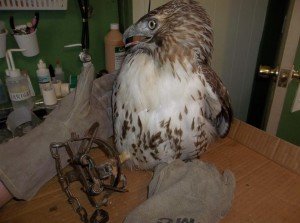
This is the kind of insanity that goes on with leghold traps.
A few years ago my friend Astrid called me on the phone. She had taken her border collie for a walk in the woods in the local 1200-acre state park, and her dog had stepped on a leghold trap.
Astrid’s dog howled as she pried it off. Luckily it had not broken his foot, although he limped for a week. Later Astrid and I met in the woods with shovels and a pickaxe and broke the chain and yanked the trap from the ground. The name and town of the owner were engraved on a metal tag.
I went home, called the Department of Environmental Conservation, and voiced my outrage. The trap had been set in the woods right next to my house. I’d released birds there. I knew the wildlife.
“Where is the trap now?” asked the officer.
“In my garage,” I said.
“What you did was illegal,” he said. “The trap is private property.”
“What? It was set in a public park!”
“Was it 100 feet from the public trail? Then it’s legal. Where do you live? I’m going to come and pick it up.”
“And do what with it?”
“Give it back to the owner.”
The officer arrived and I handed him the trap. He gazed at me, deadpan. “What happened?” he asked.
“It had a little accident,” I replied, referring to the dozen times I’d hit it with a sledgehammer.
“Do you think this is funny?” he snapped, glaring at me as if I were an eight-year-old. “I could have you arrested for Destruction of Property, Vandalism, and Malicious Mischief.”
Had I known the law better I would have said, “Excuse me, but this trap is not worth over $250 nor have I damaged it with explosives, so in the State of New York you cannot legally charge me with Malicious Mischief.” Instead I said, “Go ahead. Please. Arrest me. I have a book about injured wildlife coming out soon, and I couldn’t buy better publicity.”
He didn’t arrest me, but it looked like the trapper was going to get off scot free. However, many phone calls later Astrid and I learned that the trap had actually been set on a small piece of land just outside the state park, on which there was an easement – which made it unclear as to whether it was in the jurisdiction of DEC or the Office of Parks, Recreation, and Historic Preservation. Not only did we convince the local head of PRH that DEC was horning in on his territory, we managed to drag the president of the nearby Fish and Game Club – who personally detested trapping – into the fray. The trapper, who was not a local, ended up in court, had to pay a fine, and (we were eventually told) was not planning to trap in the area in the future.
But most of the time, that’s not the way it goes. The states which have essentially banned leghold traps are Florida, Rhode Island, New Jersey, Arizona, Colorado, Massachusetts, California, and Washington. The others allow resident psychopaths to legally indulge in their hobby of torturing whatever unlucky creature puts a foot wrong, as non-targeted animals make up a significant percentage of those who eventually die after hours – if not days -of pain and struggle.
This unlucky/lucky young Red-tailed Hawk was found and taken to Red Creek Wildlife Care in Pennsylvania. A recent thread on my Raptorcare listserv produced one wildlife rehabilitator’s nightmarish photo of a leghold trap firmly clutching the leg of a Great Horned Owl. No owl, just the leg.
Want to help ban this barbarism in other states? This website will show you how.












For those of you who really want to see what these traps can do, see the owl photo at
https://www.facebook.com/pages/Heckhaven-Wildlife-Rehabilitation-Center/135776545028.
The owl was taken in by Suzy Heck? of Heckhaven Wildlife Rehabilitation Center in Lake Charles, LA. It’s a great organization -see more of her Louisiana wildlife at http://www.heckhaven.com.
The Beautiful GHO that had his leg in the trap is also shown in the second picture on the facebook page. If you look closely you can see the left leg missing the foot. Gangreen had set in and this wonderful creature had to be euthanized. This is just one of many animals and Raptors that have come to HWRC in this, or worse, condition from these traps. Most all have to be put down as the damage from the trap or the struggling of the animal trying to escape has caused irreversable damage. And, as the traps are rarely cleaned between captures – infection sets in immediately. The release from pain and suffering is, most times, the only humane offering we can give to them.
I can’t believe these traps are allowed in the US. That’s amazing, in a very bad way.
Thanks for the story, Suzy. It’s awful.
Lisa, I can’t believe they actually allow trapping during breeding season! And I just read on the NY DEC website that in some areas you don’t have to check the traps for 48 hours. Way to protect our wildlife, DEC.
I’m with you, Jodi. Prosecute the &%$##s!
Greg, they go for anything, from opossums to squirrels to mink to raccoons. I just googled how much you get for an opossum pelt – $1.50. So much for trapping to earn a living!
Hit post before I agreed with you, Jochen. This country is crazy. They can legally trap WOLVES. But then, this is the country where Michael Vick is now a hero and a rich man.